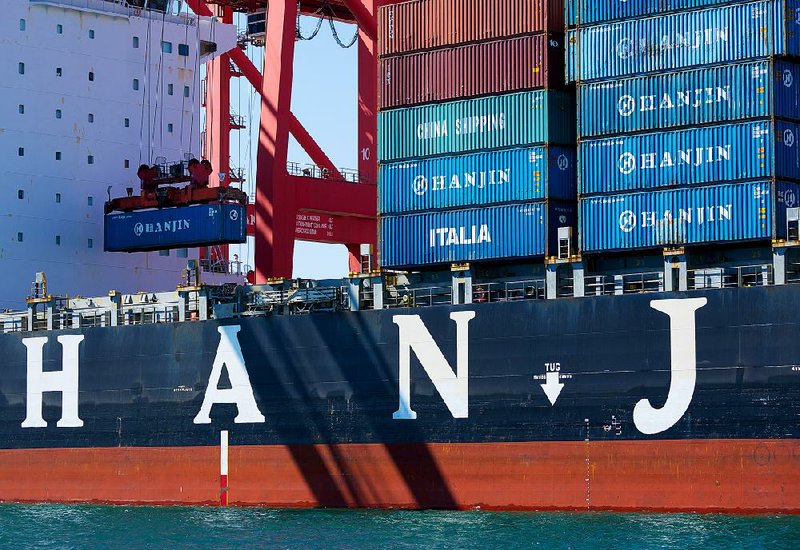LOS ANGELES -- The last Hanjin Shipping vessel dropping off goods in California has set sail from the Port of Long Beach, finally clearing the many ships left stranded by the company's sudden collapse two months ago. But in its wake, the giant shipping line has left a mess that retailers across the country will be sorting out for weeks.
The South Korean company's bankruptcy is forcing big chains to spend piles of cash to get their goods through ports to warehouses in time for the busy Christmas shopping season. Some mom-and-pop shops will have less to offer this year.
And, once again, an unexpected disruption has pointed out the intricate links of the supply chain that feeds America's consumer machine.
California's ports took a short-term hit. Long Beach, the nation's second-largest port, reported a 15 percent year-over-year drop in import traffic in September. The port of Oakland saw imports decline by 4.2 percent.
For some wholesalers and retailers, the impact continues.
Ashley Furniture, which supplies couches, beds and dressers to the likes of J.C. Penney, Target and Wal-Mart, had the misfortune of being on the receiving end of 900 containers set to be transported by Hanjin.
For weeks, Hanjin vessels idled as port operators refused to touch the cargo without certainty of how they would be paid.
When the ships finally began to offload containers, Ashley, along with several other retailers, learned that Hanjin had canceled its promised "port-to-door" delivery.
Ashley executives hustled to fill the gap, hiring trucking companies to haul the wares from ports and contracting with new vessels to ship containers stranded in Singapore. In October, the company asked a New Jersey judge overseeing the shipping line's U.S. bankruptcy proceedings to subtract Ashley's costs from the fees it owes Hanjin.
So far, the company has spent more than $1 million to collect stranded containers and get the ones that have arrived in Los Angeles out of the ports. It managed to get clients their furniture on time, but making that happen will dent Ashley's profits.
"It's going to affect our bottom line. It's all stuff that is additional bills out of our pocket," said Margaret Pronschinske, vice president of supply chain planning at Ashley.
Normally, when truck drivers drop off containers at Ashley distribution centers, they unload the goods and then take the containers back to the ports to be collected by the shipping line. But Hanjin vessels haven't been making return trips to pick up their boxes. So drivers are simply unhooking their big rigs from the chassis, the metal frames used to haul the steel boxes, and leaving the empty containers and chassis behind.
Now, Ashley is desperate to figure out what to do with hundreds of empty containers. It has returned some to port terminals, but it has had to pay Redlands trucking company $125, on top of the normal trucking rate, for each empty box it has transported.
For more than a month, those empty containers and the chassis they were tying up left the port complex in Los Angeles reeling. In all, 6,000 vacant boxes that arrived on Hanjin ships remain in the country, and the vast majority of them are still sitting on chassis.
Idle chassis are "the top issue" that retailers are worried about, said Jonathan Gold, the vice president of supply chain and customs policy at the National Retail Federation.
"They need those chassis back on the ports to get the full load of containers back out" of the ports, Gold said. "The longer this goes on, it continues to be a concern."
The strain is showing across the supply chain, said Noel Hacegaba, the chief commercial officer at the Port of Long Beach. But fixes, he says, are on the way.
Hacegaba helped persuade Hanjin to take more than 2,000 empty containers back on the Hanjin Seattle, the vessel that left Oct. 27. Last week, the Port of Long Beach announced that another Hanjin ship would return to pick up 4,300 containers.
That will be welcome news to some of the biggest names in consumer products.
Samsung had the most cargo on Hanjin ships by a long shot, with more than 8,000 container units of goods stacked on the vessels from August through the end of September, according to Datamyne, which tracks trade data. Other big names included Hanes, J.C. Penney, Microsoft and Kmart.
Most large retailers were able to pay their way around the logjam. For smaller shops, it's been harder.
Punch Studio, a gift and stationery supplier outside Los Angeles, has waited weeks for Hanjin to produce 14 containers carrying paper and gift swag that would have sold for up to $1.5 million.
Todd Kirshner, the company's chief executive, said the goods have started to trickle into his warehouse, but the delay will be costly.
"That's seven weeks less of selling time on the floor, so sales are going to be impacted dramatically," Kirshner said. He estimated that his sales could be reduced as much as 20 percent by the delays.
Kirshner also is paying up to $35 per day to a customs broker to keep six chassis and the carcasses of Hanjin containers parked near his office.
He said Hanjin's collapse has been as bad for Punch Studio as the epic congestion produced by labor disputes at the Los Angeles-area ports in 2014 and 2015.
"Whether it's a bankruptcy or slowdown, it has the same end effect," Kirshner said.
Business on 11/10/2016
